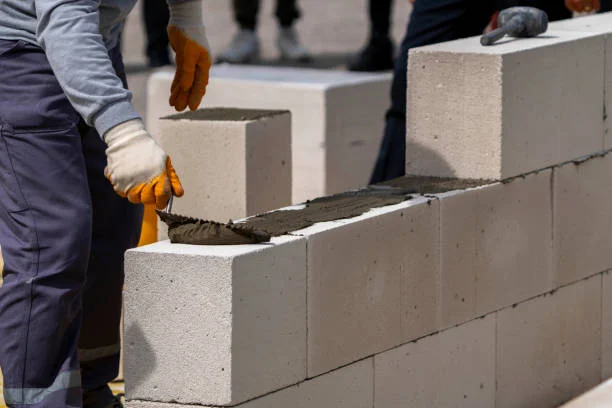Masonry and concrete are two of the most common words in construction. Many people think that they are the same thing. They both deal with walls, blocks, and hard surfaces, so the confusion is natural. But the truth is that masonry and concrete are different. Knowing this difference matters if you are building a house, repairing a wall, or doing masonry estimating and takeoff.
What Is Concrete?
Concrete is a man-made building material. It is made with the mixing cement, water, and quantities like sand, gravel, or crushed stone. When the water reacts with cement, the mix hardens and becomes very strong. This process is called curing. Concrete is poured into the forms or molds to create slabs, beams, foundations, or walls. Because it starts out wet and fluid, so you can shape it in almost any way. To make it stronger, the builders often add the steel bars or wire mesh. This turns it into reinforced concrete, which can handle heavy loads and resist cracking.
What Is Masonry?
Masonry is not a single material. It is a method of construction. Mortar is a paste made of cement, lime, and sand that hardens and holds the units together. A mason places each piece by hand, fitting it into place with care. The final wall may be load-bearing or decorative. Masonry has been used for centuries because it looks good, lasts long, and adds character to buildings.
Unlock new ideas by diving into this carefully picked related post.
The Core Question: Is Masonry Concrete?
The short answer is no. Masonry is not same as the concrete.
· Concrete is a mix that hardens into one solid mass.
· Masonry is a technique of building with units joined by mortar.
But there is overlap. When builders use concrete masonry units (CMUs), which are blocks made of concrete, the wall is considered masonry because it is built piece by piece. This is where confusion starts. A concrete block wall looks like “concrete,” however technically it is masonry built with concrete units.
Masonry vs Concrete
Let’s compare them side by side:
| Feature | Concrete | Masonry |
| Nature | A material made from cement, aggregates, and water | A method of construction using units like brick, stone, or concrete blocks |
| Form | Poured into molds or forms | Built unit by unit |
| Reinforcement | Often with steel rebar or mesh | Can be reinforced with steel and grout inside blocks |
| Flexibility in shape | Very flexible, it can form slabs, curves, or complex structures | Limited to shapes and sizes of available units |
| Speed | Faster for large pours | Slower, labor-intensive |
| Finish | Plain, needs surface treatments | Can be decorative with patterns and textures |
Concrete Masonry Units (CMUs)
The best example of overlap is the concrete block. These blocks are cast from the concrete, cured, and then used as the masonry units. The walls that built from them are called the concrete masonry.
CMUs are popular, because they are durable, fire-resistant, and easy to reinforce. Builders can put rebar inside the hollow cores of blocks and fill them with grout for strength. This makes them suitable for schools, warehouses, and residential basements.
Still, the wall is masonry in method because it involves stacking and mortar joints. The units just happen to be concrete.
Why This Matters in Masonry Estimating and Takeoff
If you are estimating the cost of a project, the distinction between concrete and masonry is not just academic. It affects your numbers in a big way.
· Cast-in-place concrete walls need formwork, reinforcement, curing time, and finishing. Labor is fast for large areas but material handling is heavy.
· Masonry walls need skilled masons to place units one by one. You must account for mortar, waste, cutting, and pointing. Labor is slower and costs more.
· Concrete block masonry (CMUs) sits between the two. Blocks are larger than bricks, so walls go up faster, but you still need mortar and potential reinforcement.
Accurate masonry estimating and takeoff requires identifying the exact type of wall. Mixing up “concrete” with “masonry” could lead to big budget errors.
Common Questions People Ask
Is masonry stronger than concrete?
It depends. Reinforced concrete usually handles loads better. Masonry strength varies with the units, mortar quality, and reinforcement.
Which is cheaper, masonry or concrete?
Concrete is cheaper for large slabs or poured walls. Masonry may cost more due to labor, but it offers beauty and design flexibility.
Can you make concrete look like masonry?
Yes. Concrete can be poured with surface molds to mimic brick or stone. But it is still concrete, not true masonry.
Does masonry crack more than concrete?
Both crack under the stress. Masonry often cracks at mortar joints, while concrete develops shrinkage or structural cracks. Good design and reinforcement reduce both.
Are there hybrid systems?
Yes. Many buildings use the reinforced concrete cores with masonry facades, combining strength with appearance.
Practical Examples
· A house basement built with poured concrete walls is concrete construction.
· A decorative garden wall built with clay bricks is masonry.
· A school wall built with CMU blocks reinforced with rebar is concrete masonry. It is a blend of both.
These real-world cases show why clarity matters. Each requires different materials, crews, and estimating methods.
Tips for the Better Estimating
1. Classify walls accurately in drawings: the poured concrete, brick masonry, stone masonry, or CMU masonry.
2. Include mortar quantities and waste factors for masonry.
3. Account for reinforcement in CMU walls where cores are filled.
4. Adjust labor rates: masonry is slower than poured concrete.
5. Consider for the finishes: pointing, cleaning, or surface treatments affect time and cost.
Masonry is not concrete. Concrete is a material you mix and pour. Masonry is a craft of building with units and mortar. They overlap when concrete is used to make blocks, but the processes and costs remain different.
For builders, homeowners, and estimators, knowing the difference is not just theory. It affects budgets, schedules, and design choices. Whether you are pricing a new wall, restoring an old building, or running a project, masonry estimating and takeoff depends on this clarity.
Explore more content crafted to inspire, guide, and empower you at Management Works Media.






